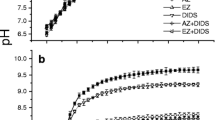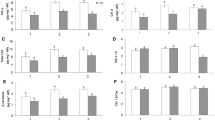Summary
The effect of photon fluence rate on the ß-dimethylsulphoniopropionate (DMSP) content of salt-stressed eulittoral green macroalgae from different geographic regions was determined. At 55 μmol photons m−2s−1 DMSP increased continuously with increasing salinities up to 68‰ in Ulothrix implexa, Ulothrix subflaccida, Enteromorpha bulbosa and Acrosiphonia arcta from Antarctica, while the Subantarctic/cold-temperate Ulva rigida and the temperate Blidingia minima showed a large rise in intracellular DMSP concentration only under gentle hypersaline treatment (51‰). At the highest salinity tested the DMSP content of the latter species declined. In contrast, the capacity to form DMSP in the dark under hypersaline conditions was very low in all species. In addition, the DMSP content of the Antarctic species was determined after one year cultivation at 0°C under photon fluence rates of 2, 30 and 55 μmol m−2s−1. All isolates increased their DMSP concentration with increasing irradiance. In contrast to previous experiments done at 10°C, these species exhibited up to 5 fold higher DMSP values at 0°C under most photon fluence rates. The data support the idea of a light-dependent DMSP biosynthesis, and also demonstrate the stimulating effect of low water temperatures on the DMSP content of Antarctic green macroalgae. Apparently, in these plants DMSP may function as a cryoprotectant.
Similar content being viewed by others
References
Andreae MO (1990) Ocean-atmosphere interactions in the global biogeochemical sulfur cycle. Mar Chem 30:1–29
Barsch D, Blümel WD, Flügel WA, Mäusbacher R, Stäblein G, Zick W (1985) Untersuchungen zum Periglazial auf der Königs-Georg-Insel. Rep Polar Res 24:1–75
Brown AD, Simpson JR (1972) Water relations of sugar-tolerant yeasts: the role of intracellular polyols. J Gen Microbiol 72:589–591
Carpenter JD, Crowe JH (1988) The mechanism of cryoprotection of proteins by solutes. Cryobiol 25:244–255
Dickson DMJ, Kirst GO (1986) The role of dimethylsulphoniopropionate, glycine betaine and homarine in the osmoacclimation of Platymonas subcordiformis. Planta 155:409–415
Dickson DMJ, Kirst GO (1987a) Osmotic adjustment in marine eukaryotic algae: the role of inorganic ions, quaternary ammonium, tertiary sulfonium and carbohydrate solutes: I. diatoms and a rhodophyte. New Phytol 106:645–655
Dickson DMJ, Kirst GO (1987b) Osmotic adjustment in marine eukaryotic algae: the role of inorganic ions, quaternary ammonium, tertiary sulfonium and carbohydrate solutes: II. prasinophytes and haptophytes. New Phytol 106:657–666
Edwards DM, Reed RH, Chudek JA, Foster R, Stewart WDP (1987) Organic solute accumulation in osmotically-stressed Enteromorpha intestinalis Mar Biol 95:583–592
Greene RC (1962) Biosynthesis of dimethyl-ß-propiothetin. J Biol Chem 237:2251–2254
Gröne T, Kirst GO (1991) Aspects of dimethylsulfoniopropionate effects on enzymes isolated from the marine phytoplankter Tetraselmis subcordiformis (Stein). J Plant Physiol 138:85–91
Gutkowski R, Maleszewski S (1989) Seasonal changes of the photosynthetic capacity of the Antarctic macroalga Adenocystis utricularis (Bory) Skottsberg. Pol Biol 10:145–148
Iverson RL, Nearhoff FL, Andreae MO (1989) Production of dimethylsulfonium propionate and dimethylsulfide by phytoplankton in estuarine and coastal waters. Limnol Oceanogr 34:53–67
Rarsten U, Wiencke C, Kirst GO (1990a) The ß-dimethylsulphoniopropionate (DMSP) content of macroalgae from Antarctica and Southern Chile. Bot Mar 33:143–146
Karsten U, Wiencke C, Kirst GO (1990b) The effect of light intensity and daylength on the ß-dimethylsulphoniopropionate (DMSP) content of marine green macroalgae from Antarctica. Plant Cell Environ 13:989–993
Karsten U, Wiencke C, Kirst GO (1991a) Growth pattern and ß-dimethylsulphoniopropionate (DMSP) content of green macro-algae at different irradiances. Mar Biol 108:151–155
Karsten U, Wiencke C, Kirst GO (1991b) The effect of salinity changes upon the physiology of eulittoral green macroalgae from Antarctica and southern Chile. II. Intracellular inorganic and organic compounds. J Exp Bot 245:1533–1539
Kirst GO (1990) Salinity tolerance of eukaryotic marine algae. Ann Rev Plant Physiol Plant Mol Biol 41:21–53
Luning K (1984) Temperature tolerance and biogeography of sea-weeds: the marine algal flora of Helgoland (North Sea) as an example. Helgol Meeresunters 38:305–317
Provasoli L (1968) Media and prospects for cultivation of marine algae. In: Watanabe A, Hattori A (eds) cultures and collections of algae. Jpn Soci Plant Physiol Tokyo, pp 47–74
Reed RH (1983) Measurement and osmotic significance of ß-dimethylsulphoniopropionate in marine macroalgae. Mar Biol Lett 4:173–181
Schmidt A (1983) Thioredoxins in the regulation of nitrogen and sulfur metabolism. In: Scheibe R (ed) Light dark modulation of plant enzymes. L Ellwanger Press, Bayreuth, pp 124–128
Tischner R, Hüttermann K (1980) Regulation of glutamine synthetase by light during nitrogen deficiency in synchronous Chlorella sorokiniana. Plant Physiol 66:805–808
Turner SM, Malin G, Liss PS, Harbour DS, Holligan PM (1988) The seasonal variation of dimethyl sulfide and dimethylsulfonium-propionate concentrations in nearshore waters. Limnol Oceanogr 33:364–375
Wiencke C (1988) Notes on the development of some benthic marine macroalgae of King George Island, Antarctica. Ser Cient INACH 37:23–47
Wiencke C, Tom Dieck I (1990) Temperature requirements for growth and survival of macroalgae from Antarctica and southern Chile. Mar Ecol Prog Ser 59:157–170
Wiencke C, Gorham J, Tomos D, Davenport J (1992) Incomplete turgor adjustment in Cladophora rupestris under fluctuating salinity regimes. Estuar Coast Mar Sci 34:413–427
Young AJ, Collins JC, Russell G (1987) Solute regulation in the euryhaline marine alga Enteromorpha prolifera (OF Müll). J Ag J Exp Bot 38:1298–1308
Author information
Authors and Affiliations
Additional information
Contribution No. 547 of the Institute for Polar and Marine Research, Bremerhaven
Rights and permissions
About this article
Cite this article
Karsten, U., Kirst, G.O. & Wiencke, C. Dimethylsulphoniopropionate (DMSP) accumulation in green macioalgae from polar to temperate regions: interactive effects of light versus salinity and light versus temperature. Polar Biol 12, 603–607 (1992). https://doi.org/10.1007/BF00236983
Received:
Accepted:
Issue Date:
DOI: https://doi.org/10.1007/BF00236983




